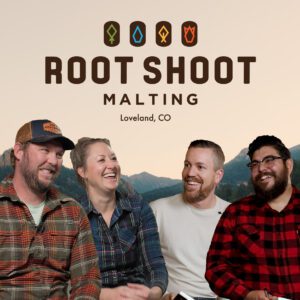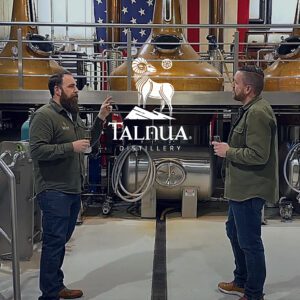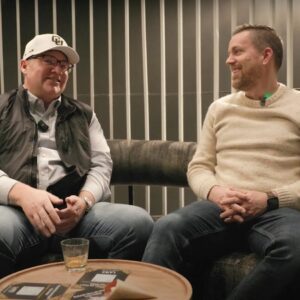Join Whiskey Wanderlust as we embark on an exclusive tour of Boulder Spirits in Boulder, Colorado! Discover how Alistair Brogan and his team are redefining American Single Malt Whiskey with authentic techniques, from sourcing Scottish malted barley to using traditional pot stills. Learn about the unique process behind crafting bold and complex whiskeys that capture the essence of Colorado’s climate and character.
Explore the nuances of distillation, aging, and the art of blending with insights into how local water sources contribute to their signature expressions. Whether you’re a seasoned whiskey connoisseur or an eager newcomer, this behind-the-scenes look will inspire your appreciation for craft distilling.
Highlights:
- Meet Alistair Brogan, the visionary founder of Boulder Spirits.
- Understand the intricate steps of creating American Single Malt.
- Discover the impact of Colorado’s climate on aging whiskey.
- Learn about their unique barrel aging and blending processes.
- Get insights into their passion for quality and innovation.
Additional Viewing
Tour Transcript
Show Transcript
Alistair Brogan 0:05
Hi, I’m Alistair Brogan. I am the owner of Boulder Spirits here in Boulder, Colorado. And what I want to take you through today is how we hear Boulder Spirits make American single malt whiskey. We bring all our malted barley in from Scotland. We use a yeast that we imported, and it’s already malted. What is malting? Malting is basically pretending it’s spring saturated with water, pretend it spring starts to germinate. Shut the germination off by blowing hot air over it. So now you’ve got this great malted barley, which you then crack open using the mill behind us to make what’s called a grist, and that’s what we’re going to be adding water to change those starches to sugars. That malting process is designed.
Cory Comer 0:52
You’re trying to maximize that of sugar in the grain, correct?
Alistair Brogan 0:55
And yes, so it’s all about yield. So what we’re trying to achieve is by getting that that grain malted, I eat the pretending it’s spring, and then cracking open, you want to make sure that the proportions of husk to flower is correct, because too much flour, things clog up too well flour, and you’re going to get a yield. And then a lot of the stories in Scotland where you’re making 50 million bottles a year, 1% is 300,000 bottles. So this stage is about yield. It’s about maximum extractions of those shoes. So here in the still room, there really is only four ingredients in single malt whiskey. There’s the malted barley, there’s a yeast, there’s the water, and there’s the new charred old barrel. There’s two other major influencers. Is that the climbing and the shape and style of the still.
Cory Comer 1:43
Who’s this guy working doing all the work for you guys?
Alistair Brogan 1:46
This is, this is Justin, our distiller here working on a Saturday, hard at work at the end of the day, single malt whiskey is unhopped. Beer distilled twice. It is as simple as that. So what we have here is a hot water tank,
you’ll notice, and I’ll talk about it more at one arm, which is 11 degrees pointed down. And this is a unique still, really designed for, first of all, malted barley. Don’t use column stills here. And secondly, is the still to give a heavy whiskey, heavy whiskey, because, as you know, American single malt whiskeys go into new charred barrels, whereas the rest of the world goes into second fill barrels. So we wanted to have a heavy whiskey to allow that to compete with that new char. So we put it through still twice the first distillation, all we’re looking to do is you’ve got alcohol and all its constituent parts and water a strip run. Alcohol boils a lower temperature than water, turn on the Steam, boil a room next door. Steam place on the floor. All the alcohol, or most of the alcohol, rises swan neck, line, arm condenser, full of cold water tubes into our beer keg and gets pumped into a retaining tank for the bag that’s called Low wines. We’ve converted an on hop year, 10% alcohol by volume, to low wines at 30 alcohol by volume. We now go through the process all over again to collect enough low wines to then fill this still to do the second distillation. This time we want to separate three chemicals, methanol, ethanol, water. Methanol, kidney failure, blindness, death. Ethanol, what you want to put in the barrels, water you want to set aside. That’s the what commonly referred to as the head hearts and tails industry. So what we do is we got heads, hearts, Tails. We cut the head off. We cut the tail off. We keep the hearts. We put that in the barrel, proof it down a little bit and put it in the barrel. We then take the methanol, and we take the tails, and we put it back into the next distillation. Okay, the next not strip in this next bit of distillation, because we’re going to pick up more flavors and tastes from that and get more alcohol out of that, the heads, hearts and tails.
Cory Comer 4:57
What’s the process of separating those so for the especially those rookies that don’t know.
Alistair Brogan 5:01
So if we’re talking about 1000 gallons in the still when we’re doing the spirit run, we’re getting about 16 gallons of that methanol. Now the methanol does have ethanol in it, but you can really taste that difference once you get to about 1516 gallons. It smells like tastes like chemical, slow cleaner. It’s very disgusting. But most people be able to tell that switch the skill is being consistent about that switch. So you’re not got methanol in and less, because that affects yield and it affects consistency. Well, about methanol is not a problem, but you got to be consistent, and then most distilleries will cut off round about the 120 so otherwise, you’re wasting a lot of energy to take strike alcohol, and then you use the methanol and the tails, and you put that into next spin around, because you’re then going to get a lot of flavors of taste from the methanol going back in again, that’s basically being re chopped up. And also you’re getting more alcohol because you’re the tails. That’s the second part of distillation. And really that process we’re doing on a normal day shift, maybe 10 barrels in a week, quite, quite comfortably with that. And then what you’ll have seen here, Justin was doing, was taking all the spent grain, putting into Niagara, going into a trailer. Farmer takes it. Milking cows get that. The beef cows get all the corn milking cows get the there’s a lot of still nutrients and a lot sugar in that. So this is a still, and you’ll notice a lot of bourbons and rice and wheat whiskeys are made in column. Stills, calm cells are very prevalent in the US. They’re industrial. They’re continuous. They make a very clean spirit. Multi barley has got a lot of depth of flavor. So what we want to do is is a batch system. So what we want to do is have longer for the debt that depth and complexity of the malt to maturate into the water. So we’re spending maybe two to two and a half times more in our time, allowing that to maturate. And this still is from Forsyth in Rothes, and it was designed specifically, as I mentioned earlier, for American single malt whiskey. And why is because the shape and the linear, that linear arm is pointing down 11 degrees to be quite exact. And it’s quite a short still. It’s got all it’s got a large swan neck. And what that allows is the big particles to evaporate, go up, come over, down the line, arm, condense a full cold water tubes into our tank. So we want big, heavy whiskey, but heavy whiskey New York bars. So the water we use, we use, and we use municipal water at the moment for our processing through a carbon filter, because anything is not right, and there’s nothing that’s not right in municipal water here, and will will be distilled out. So at this point, we don’t really are too concerned. However, in all means of water, your chlorine, the chlorine burns, where chlorine boils off, so we boil the water before we put it in the mash. Where the water becomes important is that distillate a bit that from proofing the barrel into the bottle. Because what we’ve got here is our average barrel inches, 120 proof, 60 ABV. So the very best barrels in the world for maturing whiskey is American oak, mainly from the Pacific, sorry, from the Northeast Missouri oak. They’re then taken down, they’re air dried, they’re taken down to the coupridge using in Kentucky. They’re then, first of all, toasted, then it’s charred, just like piece of bread, they’re then charred the minute you put flame on Oat. You get the natural caramelization of the caramels and vanillas in the Oak, and creates little canyons. We then put our new mixed spirit in here, we plug it, and then the Colorado climate takes over. And that was which, which makes really Colorado very unique.
Cory Comer 9:01
One of the misconceptions about aging whiskey in Colorado, some people might think it ages faster because of those, those things you’ve discussed. But as you guys talk about, it doesn’t age faster. It just simply ages differently, correct. And so all that adds to the flavor of your product, correct?
Alistair Brogan 9:17
So yes, we never say that it ages faster because there’s temporary actions happening in this barrel because of what a, what we do B, that the char, the new old char, that will not happen in other locations around the world. So if I took this barrel of new make spirit and sent it down to or up to the Pacific Northwest, or down to Texas, and then sampled a different whiskey, just like the still different whiskey, because each of the stills that they call pot stills will get a different whiskey. The barrel will give you a difference. Street whiskey is two years. We find, even in this this climate, two years isn’t actually enough. Our youngest whiskey that we ever brought out very beginning was two years. We felt that was right. And. Our averaging is obviously going up and up hence now our seven year old American single malt whiskey, which we’ve just launched. So the barrel is vitally important to the whole process. We then store it, we then taste it pretty regularly, and then the next step is the blending. The blending is really important, because not all barrels are the same. Maybe seven out of 10 will be there or thereabouts, and we’ll blend them. One will be extremely good, cash strength, and we set aside and a couple might be not great, and we put them back in the rack house, and hope they get better. So the blending is another real skill of a distillery in ensuring that you have consistency of of product.
Cory Comer 10:44
So we, out of curiosity, for your particular bottling, how many barrels do you typically blend into? Into a batch? We
Alistair Brogan 10:52
tend to blend maybe six or seven. And what we did with our cash rent bourbon is every five or six we taste one, taste spectacular set aside, and every year we take those ones, we taste them, and then put them in our cash grant bourbon release. But for the single malt whiskey we talked about, that barrel has such an impact on the whiskey that we’re tasting it way, way more. I mean, in Scotland, they’ll put it and they’ll even think about it for at least 10 years. But yeah, it matures differently, and that’s the best way of explaining it. The last part of this is really the water. Now we use municipal water for the processing. Really, when it comes to proofing down from the barrel into the bottle, it makes a world of difference in using a good water. Most Scotch whiskeys is deionized water consistency. We use a water that comes from six miles down the road, El Dorado water. We trialed it when we first started proofing down the barrel, and it made a world of difference, a huge difference, in the quality of the whiskey. And actually, most of the distilleries in Colorado are using locally, local wells or streams for proofing down. And it makes such a such a difference to your whiskey. So those are the major components in making American single malt whiskey.
Cory Comer 12:17
What are the stories the stills that you have up on the top there?
Alistair Brogan 12:20
We up here on the roof. We’ve got two stills. The first still was really an experimental still. I was even before my time. Second still is what we were making gin in. So that’s about 250 gallon still, but I’ll still make 600 bottles of gin, a D, so it’s still pretty but it was made by the previous distiller. As far as what you’ll see is the line arm and they condense her foot. But actually still was, I think it was Spanish. She was brought in from Spain.
Cory Comer 12:45
Tell us a little bit more about the process between seven years, right, bottled and bond. You’ve done a, you have a you had your seven year bottle and bond correctly, just and your 10 essentials. Tell us a little more about that process and the aging. And then, like handling all that product to go through.
Alistair Brogan 13:02
We’ll have Sherry and Port. The port barrels are the darker ones. These will be Sherry barrels. We’ve got an arm and a barrel. So we bring those barrels in from from Europe. They are still wet, so they’ve been recently emptied. We’ll have maybe nine, nine liters that’s sitting in that wood. That is what we call the devil’s cut, is sitting in the wood so it’s wet. We then put our fully matured whiskey in that we shake it all about. We leave it for about eight or nine months. And most of the whiskey, or most of that Sherry of pork, is now out into the into the whiskey. But then what we do is we get secondary flavoring from European oak, French oak. French oak will give you a different flavor profile than American oak. So it’s really, and it’s very, very traditional for malted barley to be finished in Sherry, pork, Madeira, Armagnac, etc. Bourbons, not so much. Bourbons are big flavors, not so much. But there’s some great finished bourbons on the market. So what we then do, what we then did with our 10 essentials, was we took Sherry, we took a port, we took an arm and a finished. We took some of our seven year old, older single whiskey, and then we blended it. Now it’s not just a blind blend, One to One to One to One to One. It was took us a long time to get that blend correct, where we get that quality.
Cory Comer 14:28
So you mentioned the proofing process sometimes, for these barrels, is up to four months. Is that correct?
Alistair Brogan 14:32
The proofing process itself? No, the proofing process is maybe maximum three weeks. But with the 10 essentials, because we had four different three different finishing barrels. We were taking our time in doing that. And what Ryan was saying about four months was more about going away, reblending it in small in small quantities to get the right blend. Because it wasn’t One to One to One to One. It was really. Uh, took a long
Cory Comer 15:01
time highlights the amount of love and passion you guys put into your craft. And that’s that’s impressive.
Alistair Brogan 15:06
Thank you. And it’s actually interesting, because, you know, Ryan would come in and go taste that, and he would go to other people, they distiller, and we just go, no, no, and you go back and you do it and or just right? And we don’t know what’s just race all the time. We just know what’s not right? So that just hit once he got to that, we thought, whoa. We didn’t know what we’re gonna get. We like that.
Cory Comer 15:27
So obviously, one of the things we wanted to like to do is promote them buying your product, right? So what’s the best way for them to get your product?
Alistair Brogan 15:36
So guys, our product is from the distillery, and the best way to come into the story, well, 12 o’clock to six o’clock, six days a week, Monday to Saturday. We can taste you and all our products, or as many as you can cope with. And you can buy, buy our whiskies. You can take your selection. We’re also in all the big, major liquor stores, some of the smaller ones, not so much, because they don’t have craft spirits. Or if you’re a state, you can go on to our Shopify site and purchase them to be delivered.
Cory Comer 16:10
Thank you, Alistair, thank you for your time. Thank you for showing this beautiful facility. I never get bored of doing this. If you’re in the Boulder area, come check them out. Come meet Alistair. Have a drink and also introduce yourself to Ryan too. So thanks guys. Thanks so much.





